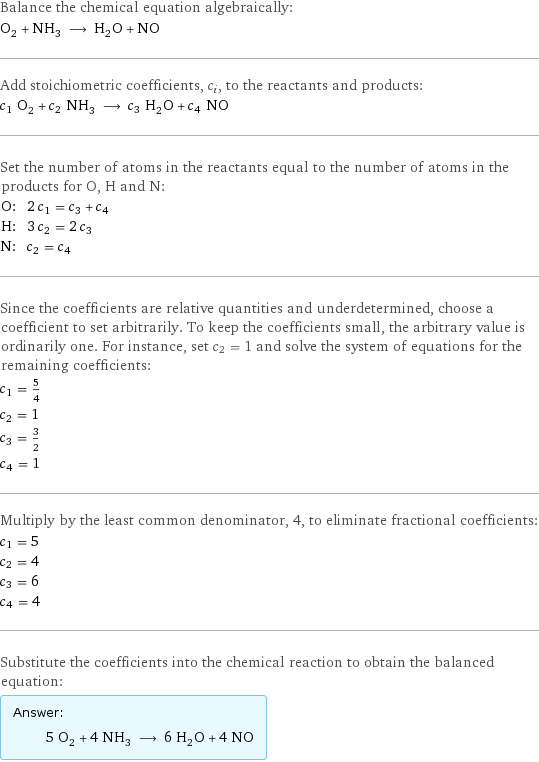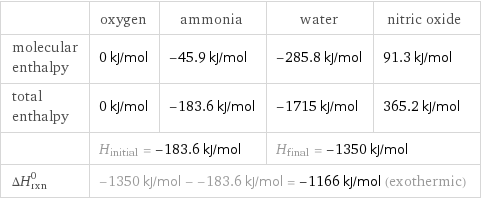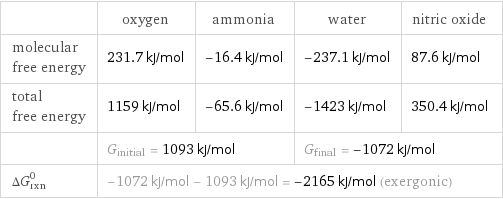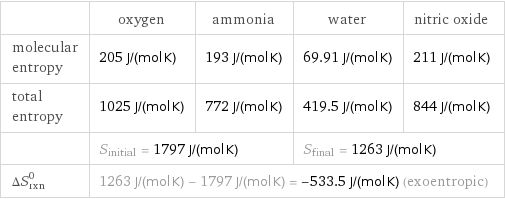Input interpretation

O_2 (oxygen) + NH_3 (ammonia) ⟶ H_2O (water) + NO (nitric oxide)
Balanced equation

Balance the chemical equation algebraically: O_2 + NH_3 ⟶ H_2O + NO Add stoichiometric coefficients, c_i, to the reactants and products: c_1 O_2 + c_2 NH_3 ⟶ c_3 H_2O + c_4 NO Set the number of atoms in the reactants equal to the number of atoms in the products for O, H and N: O: | 2 c_1 = c_3 + c_4 H: | 3 c_2 = 2 c_3 N: | c_2 = c_4 Since the coefficients are relative quantities and underdetermined, choose a coefficient to set arbitrarily. To keep the coefficients small, the arbitrary value is ordinarily one. For instance, set c_2 = 1 and solve the system of equations for the remaining coefficients: c_1 = 5/4 c_2 = 1 c_3 = 3/2 c_4 = 1 Multiply by the least common denominator, 4, to eliminate fractional coefficients: c_1 = 5 c_2 = 4 c_3 = 6 c_4 = 4 Substitute the coefficients into the chemical reaction to obtain the balanced equation: Answer: | | 5 O_2 + 4 NH_3 ⟶ 6 H_2O + 4 NO
Structures

+ ⟶ +
Names

oxygen + ammonia ⟶ water + nitric oxide
Reaction thermodynamics
Enthalpy

| oxygen | ammonia | water | nitric oxide molecular enthalpy | 0 kJ/mol | -45.9 kJ/mol | -285.8 kJ/mol | 91.3 kJ/mol total enthalpy | 0 kJ/mol | -183.6 kJ/mol | -1715 kJ/mol | 365.2 kJ/mol | H_initial = -183.6 kJ/mol | | H_final = -1350 kJ/mol | ΔH_rxn^0 | -1350 kJ/mol - -183.6 kJ/mol = -1166 kJ/mol (exothermic) | | |
Gibbs free energy

| oxygen | ammonia | water | nitric oxide molecular free energy | 231.7 kJ/mol | -16.4 kJ/mol | -237.1 kJ/mol | 87.6 kJ/mol total free energy | 1159 kJ/mol | -65.6 kJ/mol | -1423 kJ/mol | 350.4 kJ/mol | G_initial = 1093 kJ/mol | | G_final = -1072 kJ/mol | ΔG_rxn^0 | -1072 kJ/mol - 1093 kJ/mol = -2165 kJ/mol (exergonic) | | |
Entropy

| oxygen | ammonia | water | nitric oxide molecular entropy | 205 J/(mol K) | 193 J/(mol K) | 69.91 J/(mol K) | 211 J/(mol K) total entropy | 1025 J/(mol K) | 772 J/(mol K) | 419.5 J/(mol K) | 844 J/(mol K) | S_initial = 1797 J/(mol K) | | S_final = 1263 J/(mol K) | ΔS_rxn^0 | 1263 J/(mol K) - 1797 J/(mol K) = -533.5 J/(mol K) (exoentropic) | | |
Equilibrium constant
![Construct the equilibrium constant, K, expression for: O_2 + NH_3 ⟶ H_2O + NO Plan: • Balance the chemical equation. • Determine the stoichiometric numbers. • Assemble the activity expression for each chemical species. • Use the activity expressions to build the equilibrium constant expression. Write the balanced chemical equation: 5 O_2 + 4 NH_3 ⟶ 6 H_2O + 4 NO Assign stoichiometric numbers, ν_i, using the stoichiometric coefficients, c_i, from the balanced chemical equation in the following manner: ν_i = -c_i for reactants and ν_i = c_i for products: chemical species | c_i | ν_i O_2 | 5 | -5 NH_3 | 4 | -4 H_2O | 6 | 6 NO | 4 | 4 Assemble the activity expressions accounting for the state of matter and ν_i: chemical species | c_i | ν_i | activity expression O_2 | 5 | -5 | ([O2])^(-5) NH_3 | 4 | -4 | ([NH3])^(-4) H_2O | 6 | 6 | ([H2O])^6 NO | 4 | 4 | ([NO])^4 The equilibrium constant symbol in the concentration basis is: K_c Mulitply the activity expressions to arrive at the K_c expression: Answer: | | K_c = ([O2])^(-5) ([NH3])^(-4) ([H2O])^6 ([NO])^4 = (([H2O])^6 ([NO])^4)/(([O2])^5 ([NH3])^4)](../image_source/9796e59f524abf78003bdf9800c18400.png)
Construct the equilibrium constant, K, expression for: O_2 + NH_3 ⟶ H_2O + NO Plan: • Balance the chemical equation. • Determine the stoichiometric numbers. • Assemble the activity expression for each chemical species. • Use the activity expressions to build the equilibrium constant expression. Write the balanced chemical equation: 5 O_2 + 4 NH_3 ⟶ 6 H_2O + 4 NO Assign stoichiometric numbers, ν_i, using the stoichiometric coefficients, c_i, from the balanced chemical equation in the following manner: ν_i = -c_i for reactants and ν_i = c_i for products: chemical species | c_i | ν_i O_2 | 5 | -5 NH_3 | 4 | -4 H_2O | 6 | 6 NO | 4 | 4 Assemble the activity expressions accounting for the state of matter and ν_i: chemical species | c_i | ν_i | activity expression O_2 | 5 | -5 | ([O2])^(-5) NH_3 | 4 | -4 | ([NH3])^(-4) H_2O | 6 | 6 | ([H2O])^6 NO | 4 | 4 | ([NO])^4 The equilibrium constant symbol in the concentration basis is: K_c Mulitply the activity expressions to arrive at the K_c expression: Answer: | | K_c = ([O2])^(-5) ([NH3])^(-4) ([H2O])^6 ([NO])^4 = (([H2O])^6 ([NO])^4)/(([O2])^5 ([NH3])^4)